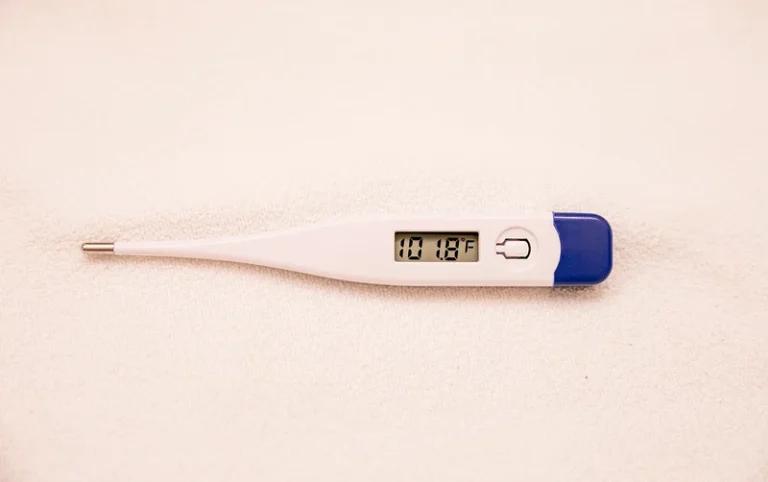Fevers can be concerning, leaving many individuals unsure of what a true fever is and when medical attention is necessary. As the body’s natural response to fighting off infection or illness, fevers play a crucial role in our overall health and well-being. However, the nuances of fever can be a challenge, with varying thresholds and potential complications to consider.
In this guide, we will look more closely at fevers, exploring the underlying mechanisms, common causes, and effective management strategies, to give you a deeper understanding of what temperature qualifies as a fever, the associated symptoms, and when to seek medical advice.
What is a fever?
A fever is a temporary increase in the body’s core temperature, often signalling an underlying health condition or the body’s immune response to an infection. Contrary to popular belief, a “normal” body temperature is not a fixed number, but rather a range that can fluctuate depending on various factors, such as time of day, age, and individual differences.
Defining a fever
Traditionally, a fever has been defined as a body temperature of 100.4°F (38°C) or higher when measured orally. However, this threshold is not set in stone, as normal body temperature can vary from person to person and even within the same individual throughout the day. Some healthcare providers may consider a temperature range between 99.5°F (37.5°C) and 100.3°F (38.3°C) to be a low-grade fever, while others may have slightly different guidelines.
The method of temperature measurement can also impact the reading. Rectal and ear (tympanic) thermometers typically yield slightly higher readings than oral thermometers, while skin (temporal artery) thermometers tend to be lower. When communicating with healthcare providers, it’s crucial to specify the type of thermometer used to ensure accurate interpretation of the fever measurement.
Fever symptoms
In addition to a high temperature, individuals with a fever may experience a range of other symptoms, including:
- Chills, shivering, and feeling cold
- Headaches and body aches
- Fatigue and lethargy
- Sweating
- Flushed skin or a feeling of heat
- Increased heart rate
For infants and young children, additional fever symptoms may include:
- Decreased appetite and poor feeding
- Earache or pulling at the ears
- High-pitched crying or fussiness
- Paleness or flushed cheeks
- Excessive thirst and decreased urination
It’s important to note that the specific symptoms associated with a fever can vary depending on the underlying cause, the individual’s age, and other underlying health conditions.
Causes of fever
Fevers can arise from a variety of causes, ranging from common infections to more serious underlying conditions. Understanding the potential triggers for a fever can help individuals and healthcare providers better address the issue.
Infectious causes
The most common causes of fever are infections, including:
- Bacterial infections: Such as urinary tract infections, skin infections, or pneumonia
- Viral infections: Including the flu, coronavirus, and other respiratory viruses
- Gastrointestinal (GI) infections: Caused by bacteria, viruses, or parasites that affect the digestive system
Non-infectious causes
Fevers can also be triggered by non-infectious factors, such as:
- Reactions to certain medications: Some medications, including antibiotics and drugs used to treat high blood pressure or seizures, can cause a fever as a side effect
- Vaccinations: Fevers are a common side effect, particularly in children, following the administration of certain vaccines, such as the diphtheria, tetanus, and acellular pertussis (DTaP) or pneumococcal vaccine
- Autoimmune disorders: Conditions like rheumatoid arthritis, where the body’s immune system attacks its healthy tissues, can lead to fever
- Cancer: Certain types of cancer, such as lymphoma or leukaemia, can trigger a fever as a symptom
Allergies, despite their name, do not typically cause fever. Allergy-related symptoms, such as sneezing, runny nose, and watery eyes, are generally not accompanied by an elevated body temperature.
Measuring body temperature
Accurately measuring body temperature is crucial for determining whether a fever is present and monitoring its progression. There are several methods available for taking a person’s temperature, each with its own advantages and considerations.
Thermometer types
- Oral thermometers: These are the most commonly used and provide a reliable measurement of core body temperature when placed under the tongue with the mouth closed
- Rectal thermometers: Considered the most accurate method, rectal thermometers measure the temperature in the rectum, which is typically 0.5-1°F (0.3-0.6°C) higher than oral readings
- Tympanic (ear) thermometers: These devices measure the temperature of the eardrum, which is often 0.5-1°F (0.3-0.6°C) higher than oral readings
- Temporal artery (forehead) thermometers: These non-invasive devices measure the temperature of the forehead and are typically 0.5-1°F (0.3-0.6°C) lower than oral readings
- Axillary (underarm) thermometers: These measure the temperature in the armpit and are generally the least accurate, often reading 0.5-1°F (0.3-0.6°C) lower than oral temperatures
Choosing the right thermometer
The choice of thermometer depends on several factors, including the individual’s age, comfort level, and the specific situation. For infants and young children, rectal thermometers are often recommended as they provide the most accurate reading. Oral thermometers are suitable for older children and adults, while tympanic and temporal artery thermometers offer a more convenient option.
Regardless of the thermometer used, it’s essential to follow the manufacturer’s instructions carefully and ensure the device is properly calibrated to obtain the most accurate temperature measurement.
Management
For most individuals, a fever is not a cause for immediate concern and can be managed effectively at home. However, there are certain situations where medical intervention may be necessary, particularly for infants, young children, and individuals with underlying health conditions.
Home care for mild fevers
If the fever is mild, generally below 101°F (38.3°C), there is usually no need for immediate treatment. The body’s natural response to fight off the underlying infection or illness is often sufficient. In these cases, the focus should be on providing supportive care, such as:
- Ensuring adequate hydration by encouraging the individual to drink plenty of fluids
- Encouraging rest and allowing the body to recuperate
- Using over-the-counter medications, such as acetaminophen or ibuprofen, to alleviate discomfort and reduce the fever
It’s important to monitor the fever and watch for any signs of worsening symptoms or complications. If the fever persists for more than a few days or the individual experiences additional concerning symptoms, it’s advisable to seek medical attention.
Treating higher fevers
For fevers above 101°F (38.3°C), or if the individual is experiencing significant discomfort, over-the-counter medications can be used to help reduce the fever and alleviate associated symptoms. Acetaminophen and non-steroidal anti-inflammatory drugs (NSAIDs), such as ibuprofen, are commonly recommended for this.
Follow the dosage instructions carefully, especially for children, and avoid giving aspirin to individuals under the age of 17, as it has been linked to a rare but serious condition called Reye’s syndrome.
Seek medical attention
While most fevers can be managed at home, there are certain circumstances when seeking medical advice is advisable:
- Infants under 3 months of age with a fever of 100.4°F (38°C) or higher should be evaluated by a healthcare provider immediately
- Children between 3 and 6 months old with a fever above 102°F (38.9°C) or who appear unusually irritable, sluggish, or uncomfortable should be seen by a healthcare provider
- Children older than 6 months with a fever lasting longer than 3 days or accompanied by concerning symptoms, such as severe headache, stiff neck, or difficulty breathing, should be evaluated
- Adults with a fever above 103°F (39.4°C) or who experience additional worrying symptoms, such as a rash, persistent vomiting, or altered mental state, should seek medical attention
In these cases, prompt medical evaluation can help identify the underlying cause of the fever and provide appropriate treatment, reducing the risk of complications.
Conclusion
Fevers can be a complex and sometimes concerning experience, but with a deeper understanding of what a fever is, individuals can manage these health challenges effectively.
Additionally, implementing preventive measures, such as vaccination and proper hygiene, can help reduce the risk of developing fevers in the first place.
Remember, while fevers can be uncomfortable, they are often a natural and necessary response of the body’s immune system. By working closely with healthcare providers and addressing any underlying conditions, you can manage fevers effectively and maintain optimal health.
Sources
Medical Disclaimer
NowPatient has taken all reasonable steps to ensure that all material is factually accurate, complete, and current. However, the knowledge and experience of a qualified healthcare professional should always be sought after instead of using the information on this page. Before taking any drug, you should always speak to your doctor or another qualified healthcare provider.
The information provided here about medications is subject to change and is not meant to include all uses, precautions, warnings, directions, drug interactions, allergic reactions, or negative effects. The absence of warnings or other information for a particular medication does not imply that the medication or medication combination is appropriate for all patients or for all possible purposes.







